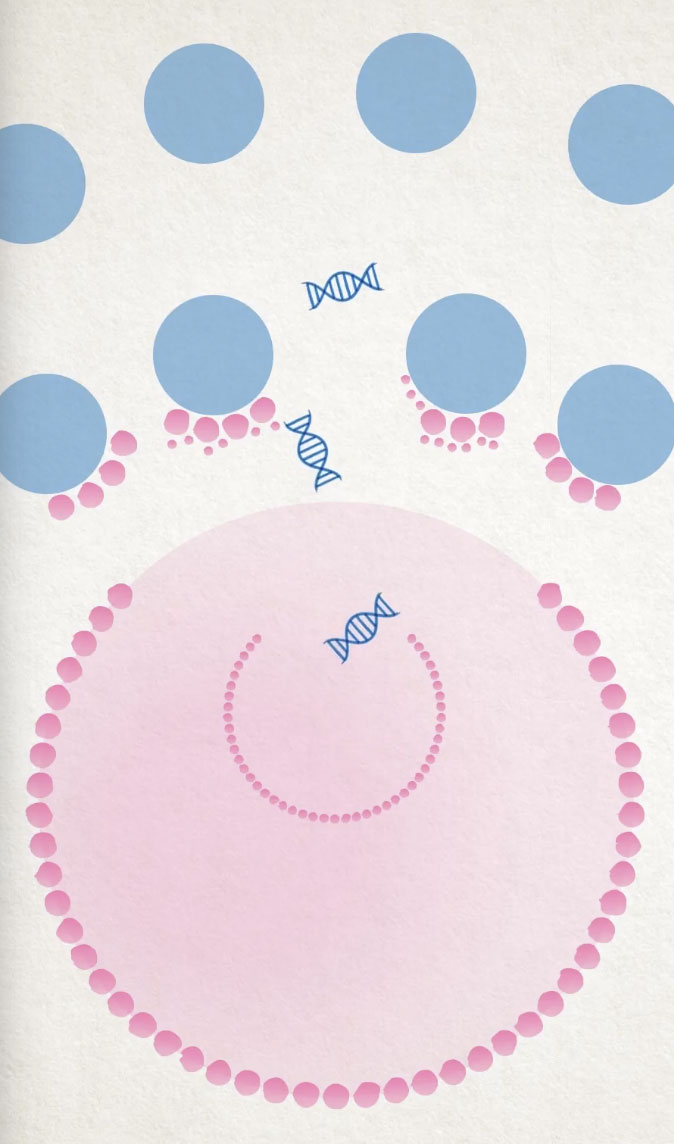Strawberry DNA
- Advanced
- A Little Messy
- 45 Minutes
- Indoor
Is strawberry DNA extraction possible?
All living things store genetic information in DNA, but can you actually extract DNA from a plant and see it with the naked eye?
Watch the video on YouTube: https://youtu.be/XYtFzVKIcgw
You Will Need
70% isopropyl rubbing alcohol
3 large strawberries
⅓ cup water
½ teaspoon salt
1 tablespoon liquid dish soap (such as Dawn)
Measuring cup
Measuring spoons
Mixing bowl
Cheesecloth
Funnel
Tall drinking glass
Small drinking glass
Resealable plastic food storage bag
Tweezers
Directions
- Ask your student to create a testable question.
- Chill the bottle of rubbing alcohol in the freezer.
- Completely line the funnel with the cheesecloth, and place the tube of the funnel down into the tall glass.
- In the mixing bowl, mix together the water, salt, and liquid dish soap. This is your extraction liquid.
- Cut the stems from 3 large strawberries. Place them in the resealable plastic bag.
- Add 3 tablespoons of the extraction liquid to the bag. Lay the bag flat on its side and press out all of the extra air. Seal the top of the bag tightly.
- Use your hands to squish and squeeze the strawberry mixture for 2 minutes.
- Pour the strawberry mush from the bag into the funnel. Let it drip into the glass until there is very little liquid left in the funnel.
- Pour the filtered strawberry mixture from the tall glass into the small drinking glass so it is one quarter full.
- Take the rubbing alcohol out of the freezer. Using the measuring cup, measure ½ cup of cold rubbing alcohol.
- Tilt the small drinking glass with the filtered strawberry mixture and SLOWLY pour the rubbing alcohol down the side of the glass. Pour until the alcohol has formed about a 1-inch deep layer on top of the strawberry mixture.
- Use your tweezers to collect the cloudy clumps that form between the alcohol and strawberry layers. This is the strawberry DNA!
- Analyze the DNA clump. What do you observe? Do you think the DNA of other fruits or vegetables will look the same? Experiment to find out!
Discovery Questions
Beginning the Experiment
- Why do you think we put the rubbing alcohol in the freezer?
- Using cold rubbing alcohol helps protect the DNA from enzymes (specific proteins) that would break the DNA down, which gives you more DNA to examine! The solubility of DNA in the rubbing alcohol is also lower when the temperature of the rubbing alcohol is lower.
During the Experiment
- Why do you think there is dish detergent in the extraction liquid?
- The dish detergent helps dissolve the strawberry cell walls so the DNA can be removed.
After the Experiment
- What else can you extract DNA from?
- Experiment! Try it with other foods and see what happens! Which foods give you the most DNA?
How it works
Strawberries are a great choice for a DNA extraction lab because they are octoploid, meaning that they have eight copies of each type of DNA chromosome. (Human cells are generally diploid, meaning they have two sets of chromosomes. Most organisms only have one genome copy per cell.)
Each component of the extraction mixture plays a part. The dish soap helps dissolve the cell membranes. The salt creates an environment where the DNA strands can clump together. DNA is not soluble in isopropyl alcohol, especially when the alcohol is ice cold, so they rise to the top when the cold alcohol is added.
A single strand of strawberry DNA is extremely tiny, too tiny to see with the naked eye, but because the DNA clumped in this activity you were able to see just how much of it three strawberries have when all of their octoploid cells are combined!
Key Words
- DNA
- DNA is an abbreviation for deoxyribonucleic acid. DNA is present in every cell of all plants and animals and determines all of the genetic traits of each living thing.
- Genes
- Genes are sections of information on DNA that determine how an organism develops
- Enzymes
- The proteins inside plant and animal cells that speed up chemical reactions
- Extraction
- The act of pulling something out of something else.
- Solubility
- The property of one substance (the solute) to dissolve in another substance (the solvent)
- Octoploid
- Having eight copies of each type of DNA chromosome

 Each component of the extraction mixture plays a part. The dish soap helps dissolve the cell membranes. The salt creates an environment where the DNA strands can clump together. DNA is not soluble in isopropyl alcohol, especially when the alcohol is ice cold, so they rise to the top when the cold alcohol is added.
Each component of the extraction mixture plays a part. The dish soap helps dissolve the cell membranes. The salt creates an environment where the DNA strands can clump together. DNA is not soluble in isopropyl alcohol, especially when the alcohol is ice cold, so they rise to the top when the cold alcohol is added.